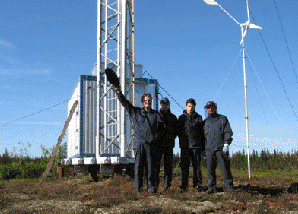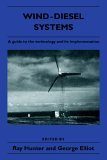
Russian turbine team
If you want a high-quality, low-cost household wind turbine, go to St Petersburg. Toomas Pungas, Project Manager, ElektroSfera, explains.
Russia is the world’s biggest country. Almost 70% of it is sparsely populated. That means 70% of the country is off the grid, including European North, Siberia and the Russian Far East. Power in these regions is usually by diesel generator. Thousands of small and big diesel power plants consume 6 to 8 millions tons of fuel annually. Some of the regions are very inaccessible, and the fuel is ferried by planes and helicopters, which is wasteful and expensive. There are villages where electricity is available only a few hours a day for morning and evening milkings.
The total population of these regions is about 10 million. Annually Russian state and local budgets spend more than $3 billion to provide distant territories with fuel.
Now they have started paying more attention to wind resources.
In Soviet times there were several plants in Russia manufacturing wind turbines. Their design was developed since the 1930s at special Institute called VetroEn. Some of those turbines still are working, some of them rotate while most were neglected. But the majority of them were either broken after a few years (by wind or by improper maintenance), or never used. I have seen several turbines in broken packing wallowing in mud in the back yard of a factory in Saint-Petersburg.
In Soviet times no one calculated costs, no one asked seriously how much, and wind turbines for electricians and power specialists in remote settlements were seen as a source of problems. Hectares of tundra was covered with empty fuel barrels, and with frames of old diesel-generators sets.
Our company established a wind energy branch five years ago(https://www.windpower.ru/english/index.htm). It was clear for us, that nowadays in Russia only the off-grid wind energy projects could be fulfilled. The main reason is low kilowatt-hour rates. Today it is about 5 cents for commercial users and 3 cents for private ones. With such rates pay-back period of grid-tie projects became too long. Other reason is lack of rules and practice to ensure connection to grid of independent generating supplies. The Russian electric companies put obstacles in the way of such attempts, which often make them unrealizable.
Two years ago we launched the 5 kW wind turbine BREEZE 5000. Its power rate was chosen in order to provide electricity to the single-family house, equipped with all modern gadgets. The turbine is small enough to be simply mounted and maintained. It could be mounted only with hand winch, without any cranes. That seems very important for remote sites.
We are completing BREEZE 5000 with charge regulator, accumulator battery and pure sinewave 5kW inverter. It is very reliable equipment, and while the wind blows it can provide you with high quality electricity. But even in ocean the calm weather lasts several days sometimes. What we can do then forget about electricity: lights, fridge, TV, washing machine etc?
So it was clear, that complete system should include diesel-generator. Our aim was the system which allows to provide 100% power supply with low costs in any distant place of Earth.
The presence of large accumulator battery permitted to solve main issue of diesel-generator as a power source. The issue is in loading condition. If you can provide diesel-generator with permanent load, which not less than 50% of it rated output, it’s OK. Of course, if you are not disturbed by permanent noise and fuel consumption. But when you supply the common so called domestic load variated broadly from 100% to almost zero – the production costs of 1 kWh rise dramatically in several times. Because when you run unloaded diesel for long time, its parts wear out very fast.
To solve this problem the diesel people used to switch on ballast load automatically, which dissipate the power into the heat. In our case we can load diesel additionally with charging current of accumulator battery. This principle is employed by other manufacturers of renewable power equipment too, but ours one have some differences.
Usually all power of diesel transforms to direct current, which charge the battery, then DC inverts to AC again. The first disadvantage of this method is double power transformation which decreases effectiveness dramatically. The other one is that as a main aim is considered the proper full charge of battery. But it is impossible to provide full load of diesel during the final stage of charge, when voltage is constant, and current decreases permanently.
In our system the diesel-generator feeds the load directly. The special unit controls the value of load current and adds the charge current thus, that their sum always is equal to 80 90% of rated current of generator. When the battery voltage achieves certain limiting value, the diesel stops automatically, and full load transfers to inverter fed by battery.
We realize that in operating mode like this the battery state of charge does not exceed 80%. But it seems not so important as utilization of total amount of diesel power. Finally, in the periods of heavy wind the battery gets the proper charge.
We began to distribute our systems at last summer. In Russia the sales of wind turbines sway in dependence of season, because it is impossible to built the foundation of mast in frozen ground. There were 14 systems installed, 6 of them are complete systems with diesel-generators. So we have got a certain experience, positive mainly.
Due to low kilowatt-hour rates in Russia we got more off-grid clients unexpectedly. It sounds like paradox, if you don’t imagine today’s Russia.
Nowadays due to Russian economic raising in suburban areas of big cities a lot of private residences are built. But usually those territories don’t possess the sufficient power infrastructure lines, substations etc. And electric companies use to say: the tariffs are too low, and we don’t have enough funds for our grid’s development. So you have a choice wait maybe 10 years, maybe more, or pay yourself for grid reconstruction. And prices sometimes are quite fantastic. If you ask 10 kW for your cottage, electric company can estimate it in 50 100 thousands dollars.
So for some of cottagers it seems preferably to buy the wind-diesel system and to became independence from electric company, even if electric lines pass just in a few meters from their fence.
In practice even in place with modest wind resources (when average wind speed don’t exceed 4 m/c) diesel runs about 10% of time. It seems average 2 3 hour in day. In windy days diesel don’t work, during calm weather diesel can starts 3 or 4 times in day for 1 -2 hour. It depends on loading condition. The adjustment of operation mode is simple enough and available for user.
Of course, diesel-generator set should be located remotely or in noise-insulated room in order to don’t disturb inhabitants at night when it starts automatically. Also the ban for the starting at night can be imposed in program. Then the system makes a cycle of charge at evening, at 9 p.m. for example.
The maintenance of system is mainly usual maintenance of diesel-generator and accumulator batteries. The wind turbine and control units are almost unwatched. Just control the fuel level in tank, as in the car.
I hope it will be a lot of work at this summer. Interest to our products was raised quickly. We are going to begin production the new 30 kW turbine soon. As BREEZE 5000 was intended to private households, the new turbine will provide the power supply of settlements in Northern and Eastern Russia.
To learn more about Wind Turbine Technology, buy these book at Amazon:
 Wind-Diesel Systems : A Guide to the Technology and its Implementation
Wind-Diesel Systems : A Guide to the Technology and its Implementation
